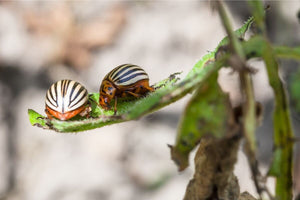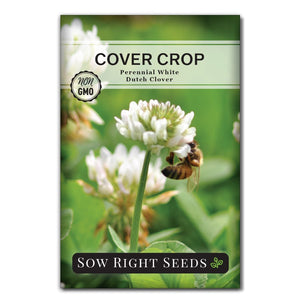What's a Cover Crop? The Benefits You Need in Your Vegetable Garden
Cover crop growing tipsFall is the perfect time to consider improving the soil for spring and summer planting. Should you mulch? Should you cover it with plastic? Instead of allowing the ground to remain bare all winter, you need to be planting cover crops.

What is a Cover Crop?
A cover crop is a crop grown to improve the soil rather than for harvesting. It is an important part of sustainable agriculture and regenerative farming.
Just as it sounds, cover crops cover the soil with a living crop. However, the purpose of this crop is to work underground rather than produce an edible or marketable product.
Benefits of Cover Crops
So how do cover crops work, and what are the benefits of growing cover crops? Cover crops can improve the soil structure to allow for better water availability, provide beneficial organisms, and add nutrients. Sometimes referred to as “green manure,” cover crops add organic matter into the soil when they are turned back into the ground.
Prevent Erosion
Cover crops have long been used as a way to preserve the soil from erosion. Having a crop in the ground helps to hold on to the nutrients and soil as well as add additional nutrients. In many gardening zones, there are several months between harvest and planting. This fallow season allows for a lot of runoff due to rain and snowmelt. Not only can the soil wash away, but the increase in rain and snow can also flush out nutrients.
Weed Suppression
In addition, a cover crop that sprouts and grows quickly can keep out weeds. A bare patch of soil may look tidy, but it’s a welcome invitation to all kinds of weeds. With a cover crop growing, the weeds don't have a chance to take hold.
Break Up Compacted Soil
The roots of a cover crop are doing some other essential work as well. The roots can break up and aerate compacted soil. Some roots dig deep, and others spread all over, creating an ideal garden soil. The roots can also add organic matter and help the growth of microorganisms.
Add Nutrients and Organic Matter to Soil
After the roots have had time to work their magic, the top growth can be mowed down and added back into the soil. This adds organic matter to the soil to improve soil structure. It will also add nutrients such as nitrogen that are needed for other crops.

Why should I grow a cover crop?
We grow cover crops every fall in our Sow Right Seeds garden. Growing a cover crop in your vegetable garden is highly beneficial. Cover crops improve soil health by adding organic matter, enhancing soil structure, and preventing erosion. They also naturally suppress weeds and control pests, reducing the need for chemical interventions. By planting a cover crop, you create a healthier environment for your vegetables, leading to better yields and a more sustainable garden overall. The simple addition of a cover crop in the fall can help improve even a small backyard garden plot.
What kind of cover crop should I grow?
What you grow as a cover crop depends on what soil improvements you want to make. We focus on three categories of cover crops, legumes, grains, and broadleaves. Each category of cover crop will have its advantages and disadvantages. Knowing your soil will help you decide which cover crop is best for your garden. You may choose to do different crops each year or in different seasons. You can also mix seeds and grow two kinds of covers together.

Types of Cover Crops
Legumes
If you want to add nitrogen and phosphorus to your soil, try a cover crop of Crimson Clover, White Dutch Clover, Austrian Winter Pea, or Hairy Vetch. The bacteria in the roots of legumes form root nodules that take nitrogen from the air and “fix” it into a form of nitrogen that subsequent plants can use. Squash, cabbage, and broccoli are some plants that can appreciate the extra nitrogen.
Grains
To slow down erosion while breaking up compacted soil, consider planting Winter Oats or Winter Rye. With their deep and hairy root system, these grains help develop a softer soil that will allow better water penetration. These work especially well in a no-till garden.
Broadleaves
If you want to suppress weeds and reduce soil pathogens, try Yellow Mustard, Annual Buckwheat, or Radish Daikon Driller. Studies have shown that these cover crops release biotoxic compounds that act as natural fumigants. Till them into the soil, and in the spring, your garden will be ready for peas, carrots, and potatoes.
When to Plant Cover Crops
Most cover crops are planted based on frost dates and can vary depending on the variety and your region’s climate. In general, cover crops need time to establish before winter cold sets in, or a few weeks in warm seasons before you turn them under as green manure.
Cover Crop Planting Times by Variety:
Here are a few quick tips for each cover crop. For more information, refer to our growing guides for each variety.
Winter Oats
- Best Time to Plant: 40-60 days before your first average killing frost (late summer/early fall).
- Ideal Soil Temp: Germinates as low as 38°F, but 60°F is best.
Crimson Clover
- Best Time to Plant: Late summer to early fall, 6-8 weeks before the first frost.
- Spring Option: Can be planted after early spring crops in cooler climates.
Austrian Winter Peas
- Best Time to Plant: Late summer, early fall, or early spring.
- Management: Mow in spring before pods form to direct nitrogen back into the soil.
Winter Rye
- Best Time to Plant: Late summer to late fall, usually around the first light frost
- Cold Hardiness: Tolerates temperatures as low as -30°F.
Hairy Vetch
- Best Time to Plant: 40-50 days before the first frost.
- Dormant Seeding: Plant just before the ground freezes for spring growth.
White Dutch Clover
- Best Time to Plant: Fall or Spring.
- Fall Planting: Allow at least 40 days before the first frost.
Yellow Mustard
- Best Time to Plant: Fall; germinates best at 55-75°F.
- Cold Hardiness: Winter-kills around 26°F. For warmer zones, mow it before going to seed to avoid reseeding.
Daikon Radish (Daikon Driller)
- Best Time to Plant: At least 6 weeks before the first frost.
- Cold Hardiness: Winter-kills around 25°F.
Buckwheat
- Best Time to Plant: Late spring to late summer.
- Quick Maturity: Reaches maturity in 70-90 days. Turn it under any time; not frost-hardy.
How do I plant a cover crop?
Cover crops can be planted individually or as part of a mix.
Plant the seeds thickly, not your regular careful spacing, but more like sowing grass seed.
Cover with soil and water well.
For most cover crops, once they set flowers, they are ready to be mowed and turned back into the soil. Depending on the crop, you can either cut it down and turn it all into the ground or take the cuttings and put them into your compost pile. Sometimes, it’s too much plant material to turn into the soil, and it will need time to break down in the compost pile.
Allow 2-4 weeks for the cover crop to break down before planting your next crop. The process of decomposing can keep other small seeds from germinating.
Additional Questions?
Each cover crop type can behave differently based on your specific conditions. For in-depth guidance, please refer to the cover crop section on our website for articles on each crop variety.
Now you know how easy and beneficial a cover crop can be. Give it a try and see what a difference it makes in your garden.
Written by Beverly Laudie
If you found this blog helpful, share it with a gardening friend!










Leave a comment